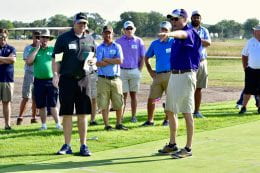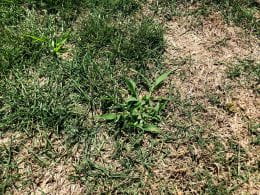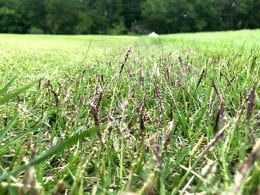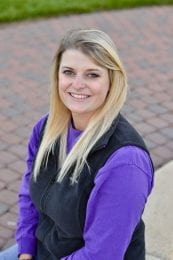Category: Turfgrass News
Today would have been the 2020 Turfgrass Field Day!!!
By Brooke Garcia
Did you know that today would have been the K-State Turfgrass Field Day? We wish we could be together at Rocky Ford in Manhattan — presenting research, providing problem diagnosis, networking with our commercial exhibitors, and gazing at the amazing equipment displays!

We do plan to post written and video research updates throughout the remainder of the year on the Turf and Landscape Blog, accessible through our website: https://www.k-state.edu/turf/
Be sure to tune in over the next couple of weeks. We will be highlighting research and providing some awesome visuals of Rocky Ford Research Station in honor of the 2020 Turfgrass Field Day.
Thanks for your continued support! We can’t wait to connect again in-person one day. May the grass be greener on the other side.
Dr. Keeley to Serve as Permanent Department Head of HNR
We had to share this exciting news that our very own Turfgrass research and teacher professor has been named the head of the Department of Horticulture and Natural Resources.
Here is the most recent press release that was released on August 6, 2020.
Keeley tabbed to lead horticulture and natural resources at K-State
Longtime professor has experience in teaching, research and extension
MANHATTAN, Kan. – Steve Keeley, who is beginning his 25th year in teaching, research and extension at Kansas State University, has been named the head of the Department of Horticulture and Natural Resources.
Keeley was the department’s interim leader since October, 2018. Ernie Minton, dean of the College of Agriculture, recently announced that Keeley will now move into the position permanently.
“As a longtime member of the K-State faculty, Steve is well-positioned to lead the department in adapting to emerging challenges brought on by the pandemic, while recognizing the opportunities for building on the department’s areas of strength,” Minton said. “Steve’s calm demeanor, coupled with the esteem in which he is held by his colleagues, will serve the department very well.”
Keeley will lead a department that includes programs in horticulture, park management and conservation, and wildlife and outdoor enterprise management. He said he is especially excited about working with “wonderful faculty who are nationally and internationally known for their outstanding teaching, research and extension accomplishments.”
The department’s undergraduate programs each rate in the top five nationally and K-State graduates are in high demand, he said, “not only in Kansas, but across the nation.”
“The research our faculty and graduate students are doing is so diverse and impactful; it’s exciting and really keeps me on my toes,” Keeley said. “We are also known for our innovative extension programs that serve the needs of Kansans and beyond the state.”
For most of his career, Keeley has held an 80% teaching and 20% research appointment in the department. His research interests include low-input turfgrass management and weed control, and he has published more than 175 articles, reports and abstracts on his research – including 34 refereed journal articles.
He has served as a senior editor for the professional journal, Crop, Forage and Turfgrass Management, and is on the editorial board of the NACTA Journal, published by the North American Colleges and Teachers of Agriculture. Keeley is also a teaching fellow for NACTA.
In 2014, he received the prestigious Crop Science Society Teaching Award, just the second turfgrass scientist ever to receive that honor. During his K-State career, he has helped to acquire more than $1.1 million in grant funding for research.
His teaching duties include introductory horticulture, horticultural pest management, turfgrass management and turfgrass pest management. He also advises undergraduates in K-State’s golf course and sports turf management program.
Keeley earned undergraduate and doctoral degrees from Colorado State University, and a master’s degree from Michigan State University.
“I am honored and humbled to be entrusted to lead the Department of Horticulture and Natural Resources at K-State,” Keeley said. “The people in this department are second to none, and I am excited to work together with them to continue making the department elite nationally.”
Learn more about the department online at https://hnr.k-state.edu.
Story by:
Pat Melgares P: 785-532-1160 E: melgares@ksu.edu
USGA Highlights Kansas City’s Professional Sports Venues
Consider Postemergence Crabgrass Control When Plants are Young (Now)
By Dr. Jack Fry
Crabgrass is now becoming quite visible. If you didn’t apply a preemergence herbicide, or had some crabgrass emerge even where it was applied, now is the time to consider postemergence control. If a preemergence herbicide was applied, but you’re still seeing crabgrass, there may have been variability in uniformity of delivery over the area to which it was applied. If new sod was laid recently, it’s common for crabgrass to emerge through the seams. Control is easier when plants are young, for they are rapidly growing and have a thinner leaf cuticle. Make sure the crabgrass plant isn’t under stress before you apply the herbicide; rainfall or irrigation on the area within a few days prior to application can help ensure the herbicide is absorbed and translocated. Dr. Hoyle wrote a nice summary of best approaches to postemergence crabgrass control here: https://blogs.k-state.edu/turf/postemergent-crabgrass-control
In addition, consider purchasing Turf Weed Control for Professionals, which was developed by cooperatively by numerous universities in the Midwest, including K-State. It can be purchased as a hard copy or a PDF download here: https://mdc.itap.purdue.edu/item.asp?Item_Number=TURF-100

Zoysiagrass Seedhead Suppression
By Dr. Jack Fry
Below-average spring temperatures and a lot of cloud cover haven’t been beneficial for growth of warm-season grasses. Nevertheless, days are getting longer, and Meyer zoysia began to produce seedheads in northeast Kansas last week. Significant work was done at K-State on zoysia seedhead suppression by Dr. Jared Hoyle, along with Dr. Aaron Patton at Purdue University. Seedheads on Meyer have a purple tone to them, but after mowing, the seed stalks leave an undesirable white cast on golf course fairways and tees. The plant growth regulator ethephon (trade name Proxy) is effective at suppressing zoysia seedheads if it is applied at the proper time the previous autumn. Manoj Chhetri, a current Ph.D. student, is working on better refining application time for Proxy to suppress zoysia seedheads. The Golf Course Superintendents Association of America, along with the Heart of America Golf Course Superintendents Association and Kansas Turfgrass Foundation, are sponsoring this zoysia seedhead suppression research that is summarized in Golf Course Management magazine (link below).
https://www.gcmonline.com/course/environment/news/zoysiagrass-seedheads

Progress in Bermudagrass Breeding
By Dr. Jack Fry
https://newprairiepress.org/cgi/viewcontent.cgi?article=7770&context=kaesr
Hoyle to join Corteva on March 30, 2020
After a productive seven years that provided a foundational learning experience not only for my personal growth but also professional growth, I will be joining Corteva Agriscience on March 30, 2020, as a Turf and Ornamental Territory Manager serving Colorado, North Dakota, South Dakota, Nebraska, Missouri and most importantly continuing to serve the great state of Kansas. This decision was not taken lightly given the high quality and professional expectations of the faculty, staff, and students at Kansas State University and additionally the continued commitment to the advancement of the turf industry by the incredibly talented and supportive professionals in Kansas. The current and future professional opportunities at Corteva are ones that my young growing family could not decline. Along with the professional factors, this opportunity provides my wife, daughter and me the ability to continue to grow in Manhattan with the increased flexibility as to where we live in the future. Interim Department Head, Dr. Steve Keeley, is currently working with upper administration in addition to the KSU Turf Team to ensure that the responsibilities associated with my position as Associate Professor as well as my responsibilities as the Rocky Ford Turfgrass Research Center Director be delegated to the appropriate party and peoples. I cannot reiterate enough how appreciative I am to everything Kansas State University has provided me through the years. From tenure and promotion to Associate Professor to an open and welcoming environment to improve my leadership skills and finally but most importantly by providing a “second family” as I began my career and family thousands of miles away from my immediate family. I believe that specific openness and welcoming support of the turf industry in Kansas and surrounding states will help continue the success of the Kansas State University’s turf program. Thank you for the last seven years! I will always be grateful for the memories made at Kansas State University.
-Jared Hoyle, Associate Professor, jahoyle@ksu.edu
Great Article on Atrazine and Simazine!
By: Brooke Garcia
NC State recently wrote up an article called, “Are Changes Coming for Atrazine and Simazine?”
Both Atrazine and Simazine were reviewed in 2013, and there are proposed changes for using each of these. To learn more, visit the article.
Full Reports for each pesticide can be found in the following links:
Student Spotlight: Dani McFadden
By Brooke Garcia
 Meet Dani McFadden!
Meet Dani McFadden!
Dani McFadden is currently enrolled at Kansas State University pursuing her M.S. in Turfgrass Science, with an emphasis in Weed Science. She anticipates graduating in May 2021.
McFadden also holds an undergraduate degree from K-State in Horticulture, with a focus in Golf Course and Sports Turf Management.
When outside of class, McFadden loves walking around golf courses, sports fields, and home lawns to apply what she is learning in school. She enjoys being able to identify weeds and common diseases, as well as applying her knowledge of herbicides and fungicides.
McFadden’s favorite hobbies include playing golf with friends, fishing, and attending sporting events. More specifically, she likes attending sporting events that are played on natural grass.
Research Focus: Testing Labeled Restrictions on Seeding Timings after Herbicide Application
Here is what McFadden has to say about her research…
“Many people want to know when they can seed their lawn after herbicide application. Most labels restrict seeding until 2-4 weeks after application. My research includes seeding a stand 0, 3, 7, and 14 days after herbicide application along with the effects of different irrigation amounts on seedling germination. I am also doing research on tall fescue conversion to buffalograss after glyphosate applications.”
What’s next for Dani McFadden?
McFadden will always love mowing greens in the early morning while watching the sunrise. This is something she hopes everyone will have the chance to do. Looking ahead, she hopes to start a career with a chemical company as a territory manager. Through networking, she can continue to connect with great superintendents and turf managers in this industry. The “people in this industry is what makes being a turfgrass student so great,” says McFadden.
